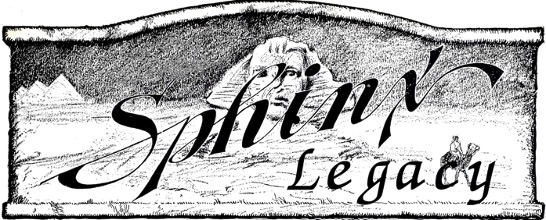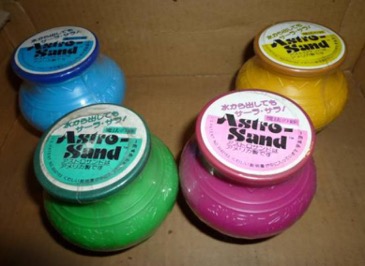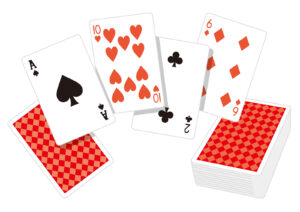“Sphinx Legacy” 編纂記 第42回
 加藤英夫
加藤英夫
赤い砂、青い砂、緑の砂を水鉢の中に入れてかきまわし、それから水鉢の中から色別に砂を取り出して見せるというマジックの話です。
出典:”Sphinx”,1926年12月号 執筆者:Leslie P. Guest
Laurant is also using a version of the East Indian Sand Trick he developed for Houdini, who unfortunately will never use it. In this version handfuls of three different colored sands are dumped in a bowl of water and stirred up. Now Laurant not only brings forth a dry handful of any color called for, but extracts all the sand of that color, for after producing the three colors the bowl is shown to contain nothing but water.
Laurantのショーで’East Indian Sand Trick’が演じられていたというので、このマジックについて検索してみました。”Sphinx”の中にはあまり見つかりませんでした。この号より前の号に出ていたのは、1918年5月号と1919年1月号に、Great Davis Showで演じられていた報告だけです。しかもどちらも’East Indian Sand Trick’をうまく演じていた、という程度の書き方でした。
私は’East Indian Sand Trick’という名称が、どんなマジックであったかはっきり知りませんでしたが、もしかするとテンヨーでも売っていたことがある、あのトリックでないかと思って、調べることにしました。そうするとすぐに、このマジックの名称が”Sphinx”でもあまりヒットしなかった理由が、”justalan.com”サイトを見てわかりました。それは砂を使うマジックについての特集でした。その最初に’East Indian Sand Trick’について以下のように書かれています。
Effect where a bowl of wet sand yields up successively different colored handfuls of dry sand. Invented by Indian conjurors and introduced by them to England in 1818 when billed as “Changing Sand to Different Colours.”
Thence adopted by the British conjuror, Ingleby, in England in 1822. Performed in the West notably in 1875 by De Kolta, in 1892 by “Alberto” (Albert Tiltman, who had toured India in 1875), David T. Bamberg, Richard Davis (by 1910), Linga Singh (from 1919 to 1937), Doc Nixon, Harlan Tarbell (by 1936), William Arenholtz, Eugene Laurant, David “Fu Manchu” Bamberg (in 1937), Dante, Jack Gwynne (in 1955), and Doug Henning (since 1981).Exposed in 1896 (Roterberg, 109-110; thence Hercat; 1917 Elbiquet; 1922 Branson; and by Doc Nixon in the Nov 1929 issue of The Sphinx).
This is an effect still in search of a single jargon term, although “The Colored Sands,” as occasionally proposed, would do the trick. However, the most usual term (although we shall see it is also applied to the non-colored version) is “Sands of the Desert” by 1974 Tannen cat #10; 1977 Kaye; 1978 Feinman citing Healey’s Magic Co; 1984 Klamm ad in LR; 1988 Waters; 1988 R. Russell in Magigram.Also called variously “The Colored Sands” (1896 Roterberg), the “Indian Sand Trick” (1897 Hercat; 1912 Day & Levani), “The Sand Trick” (1917 Elbiquet), the “coloured sands” (1922 Branson), the “Arabian Sands” (1929 Holden in Sphinx, the “East Indian Sand Trick” (1929 Nixon), “Sands of the Desert” (1930, Lippy), the “Coloured Indian Sand Trick” (1933 Davenport cat), the “colored sand trick” (1937 Annemann; 1937 [Rhinehart] in Variety; 1986 Olson), the “dry-sands trick” (1949 Hay), the “East Indian Sands Trick” (1968 Furst), “The Shifting Sands” (1976 Owen cat #9), “Sands of Egypt” (1981 Henning billing), “Sands of Egypt” (1985 Ho in LR), “the sand trick” (1985 Price), and the “Indian Sands Trick” (1986 Olson; 1986 Dawes & Setterington)
これだけ異なる名称で呼ばれていたことにも驚かされますが、それだけ違う名前のものをこれだけリストアップできるというのは、このサイトの執筆者はいったいどのような記録をとっていたのでしょうか。
この原稿を書いている最中に、テンヨーで売っていたものの商品名を思い出しました。’アストロサンド’というものでした。砂が撥水加工されているので、丸めて水の中に入れると、丸まったままになっているのです。客に色を指定させ、その色の砂の塊を水の中から両手で取りだし、バラバラと落として見せるのです。
以下にアクセスすると、Louis De Matosがこのマジックを演じているのが見られます。
“Sphinx Legacy編纂記”執筆中に、テンヨーの’アストロサンド’の広告が、”Aucview.aucfan.com”サイトに見つかりました。以下の写真は同サイトからの引用です。

(つづく)


